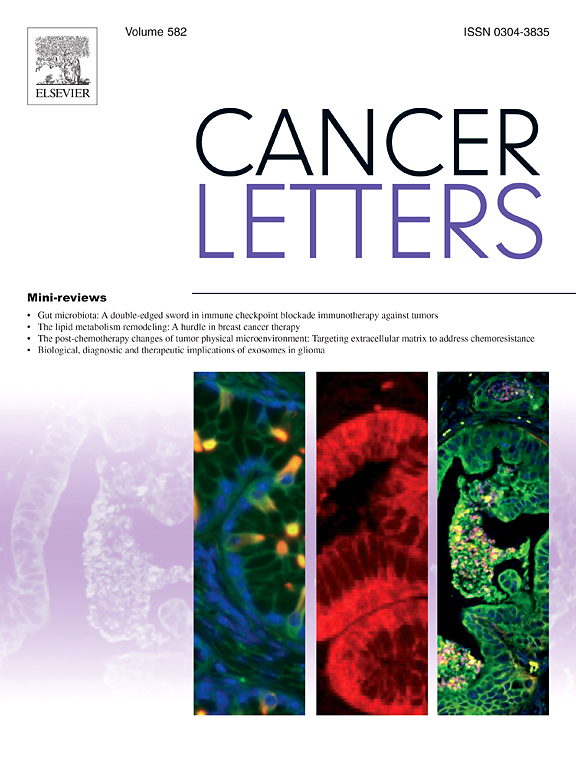Strategies for early detection and detailed characterization of oral lesions and head and neck squamous cell carcinoma in Fanconi anemia patients
IF 9.1
1区 医学
Q1 ONCOLOGY
引用次数: 0
Abstract
Fanconi Anemia (FA) is an inherited disorder associated with profound DNA repair defects, marked by failure to thrive, congenital malformations, progressive bone marrow failure (BMF), and an increased susceptibility to cancer. Clinical manifestations of FA vary widely, with BMF and clonal evolution predominantly affecting younger individuals, while adults are more frequently presenting with solid tumors. Individuals with FA are at a 500-fold increased risk of developing head and neck squamous cell carcinoma (HNSCC), which tends to appear at a median age of 30 years, often at advanced stages with only a 57 % two-year survival rate. The DNA repair deficiency prohibits the use of cisplatin and radiation therapy, limiting the treatment options for FA patients. Given the critical importance of early HNSCC detection in FA patients, innovative and less invasive diagnostic techniques are needed. This review discusses the role of brush biopsy-based cytology combined with molecular and morphometric analyses, as well as next-generation sequencing. Cytology alone demonstrated significant potential for detecting high-grade oral epithelial dysplasia and early-stage HNSCC, achieving sensitivities and specificities of 97.7 % and 84.5 %, respectively. Such techniques allow for stringent surveillance of the oral cavity in FA patients, essential given the aggressive nature of HNSCC in FA and the limited treatment options. In the absence of oral mucosal lesions, a six-month follow-up is recommended. For oral lesions persisting beyond three weeks, diagnostic evaluation is warranted, with clinical follow-up every three months for low-grade dysplasia and treatment of high-grade dysplasia. Integrating modern diagnostic tools within a comprehensive screening framework, alongside patient participation, is essential for personalized care, improved surveillance, and developing preventive measures to enhance FA patient care.
范可尼贫血患者口腔病变和头颈部鳞状细胞癌的早期发现和详细特征的策略。
范可尼贫血(Fanconi Anemia, FA)是一种遗传性疾病,与严重的DNA修复缺陷有关,其特征是发育不良、先天性畸形、进行性骨髓衰竭(BMF)和对癌症的易感性增加。FA的临床表现差异很大,BMF和克隆进化主要影响年轻人,而成年人更常以实体瘤为表现。FA患者发生头颈部鳞状细胞癌(HNSCC)的风险增加了500倍,这种疾病往往出现在中位年龄30岁,通常是晚期,两年生存率只有57%。DNA修复缺陷禁止使用顺铂和放射治疗,限制了FA患者的治疗选择。鉴于在FA患者中早期发现HNSCC的重要性,需要创新的、侵入性较小的诊断技术。本文综述了基于刷活检的细胞学,结合分子和形态计量学分析以及下一代测序的作用。单独的细胞学检查显示了检测高级别口腔上皮发育不良和早期HNSCC的显著潜力,分别达到97.7%和84.5%的敏感性和特异性。这些技术允许对FA患者的口腔进行严格的监测,考虑到FA中HNSCC的侵袭性和有限的治疗选择,这是必不可少的。如果没有口腔黏膜病变,建议随访6个月。对于持续超过三周的口腔病变,有必要进行诊断评估,每三个月对低级别发育不良和高级别发育不良进行临床随访。在患者参与的基础上,在全面筛查框架内整合现代诊断工具,对于个性化护理、改进监测和制定预防措施以加强FA患者护理至关重要。
本文章由计算机程序翻译,如有差异,请以英文原文为准。
求助全文
约1分钟内获得全文
求助全文
来源期刊

Cancer letters
医学-肿瘤学
CiteScore
17.70
自引率
2.10%
发文量
427
审稿时长
15 days
期刊介绍:
Cancer Letters is a reputable international journal that serves as a platform for significant and original contributions in cancer research. The journal welcomes both full-length articles and Mini Reviews in the wide-ranging field of basic and translational oncology. Furthermore, it frequently presents Special Issues that shed light on current and topical areas in cancer research.
Cancer Letters is highly interested in various fundamental aspects that can cater to a diverse readership. These areas include the molecular genetics and cell biology of cancer, radiation biology, molecular pathology, hormones and cancer, viral oncology, metastasis, and chemoprevention. The journal actively focuses on experimental therapeutics, particularly the advancement of targeted therapies for personalized cancer medicine, such as metronomic chemotherapy.
By publishing groundbreaking research and promoting advancements in cancer treatments, Cancer Letters aims to actively contribute to the fight against cancer and the improvement of patient outcomes.
 求助内容:
求助内容: 应助结果提醒方式:
应助结果提醒方式:


